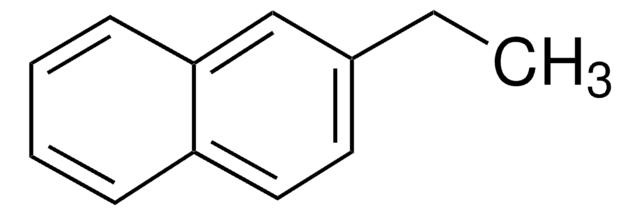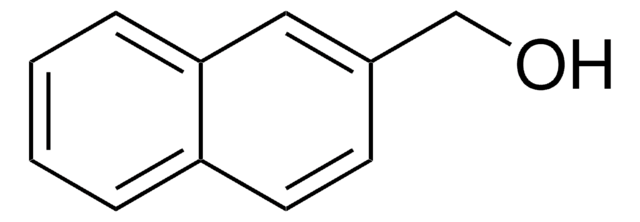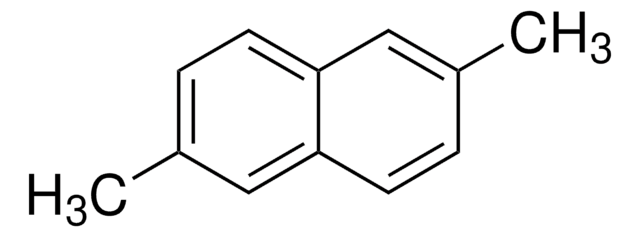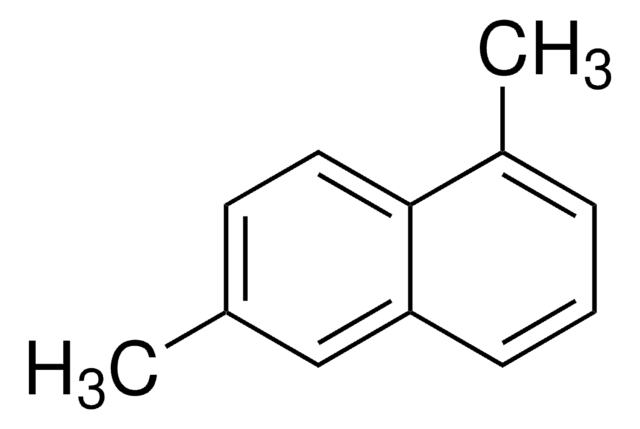M57006
2-Methylnaphthalene (β)
95%
Synonym(s):
β-Methylnaphthalene
Sign Into View Organizational & Contract Pricing
All Photos(3)
About This Item
Linear Formula:
C10H7CH3
CAS Number:
Molecular Weight:
142.20
Beilstein:
906859
EC Number:
MDL number:
UNSPSC Code:
12352100
PubChem Substance ID:
NACRES:
NA.22
Recommended Products
Assay
95%
bp
241-242 °C (lit.)
mp
34-36 °C (lit.)
density
1 g/mL at 25 °C (lit.)
SMILES string
Cc1ccc2ccccc2c1
InChI
1S/C11H10/c1-9-6-7-10-4-2-3-5-11(10)8-9/h2-8H,1H3
InChI key
QIMMUPPBPVKWKM-UHFFFAOYSA-N
Gene Information
human ... CYP1A2(1544) , CYP2A6(1548)
mouse ... Cyp2a5(13087)
Related Categories
Signal Word
Warning
Hazard Statements
Precautionary Statements
Hazard Classifications
Acute Tox. 4 Oral - Aquatic Chronic 2 - Eye Irrit. 2 - Skin Irrit. 2 - STOT SE 3
Target Organs
Respiratory system
Storage Class Code
11 - Combustible Solids
WGK
WGK 2
Flash Point(F)
208.4 °F - closed cup
Flash Point(C)
98.0 °C - closed cup
Personal Protective Equipment
dust mask type N95 (US), Eyeshields, Gloves
Choose from one of the most recent versions:
Already Own This Product?
Find documentation for the products that you have recently purchased in the Document Library.
Customers Also Viewed
Kazutoshi Shindo et al.
Bioscience, biotechnology, and biochemistry, 75(3), 505-510 (2011-03-11)
We performed combinational bioconversion of substituted naphthalenes with PhnA1A2A3A4 (an aromatic dihydroxylating dioxygenase from marine bacterium Cycloclasticus sp. strain A5) and prenyltransferase NphB (geranyltransferase from Streptomyces sp. strain CL190) or SCO7190 (dimethylallyltransferase from Streptomyces coelicolor A3(2)) to produce prenyl naphthalen-ols.
Gro Harlaug Olsen et al.
Marine environmental research, 72(4), 179-187 (2011-09-13)
Reliable risk assessment approaches for Arctic environments are requested to manage potential impacts associated with increased activities in Arctic regions. We performed toxicity tests on Arctic and temperate species exposed to the narcotic acting oil component, 2-methyl naphthalene. The experimental
Michael Safinowski et al.
Environmental microbiology, 8(2), 347-352 (2006-01-21)
The sulfate-reducing culture N47 can utilize naphthalene or 2-methylnaphthalene as the sole carbon source and electron donor. Here we show that the initial reaction in the naphthalene degradation pathway is a methylation to 2-methylnaphthalene which then undergoes the subsequent oxidation
Drazenka Selesi et al.
Journal of bacteriology, 192(1), 295-306 (2009-10-27)
The highly enriched deltaproteobacterial culture N47 anaerobically oxidizes the polycyclic aromatic hydrocarbons naphthalene and 2-methylnaphthalene, with sulfate as the electron acceptor. Combined genome sequencing and liquid chromatography-tandem mass spectrometry-based shotgun proteome analyses were performed to identify genes and proteins involved
Michael Safinowski et al.
Environmental science & technology, 40(13), 4165-4173 (2006-07-25)
The sulfate-reducing enrichment culture N47 can grow on naphthalene or 2-methylnaphthalene as the sole carbon and energy source. Here we show that the culture can furthermore cometabolicallytransform a variety of polycyclic and heteroaromatic compounds with naphthalene or methylnaphthalene as the
Our team of scientists has experience in all areas of research including Life Science, Material Science, Chemical Synthesis, Chromatography, Analytical and many others.
Contact Technical Service












